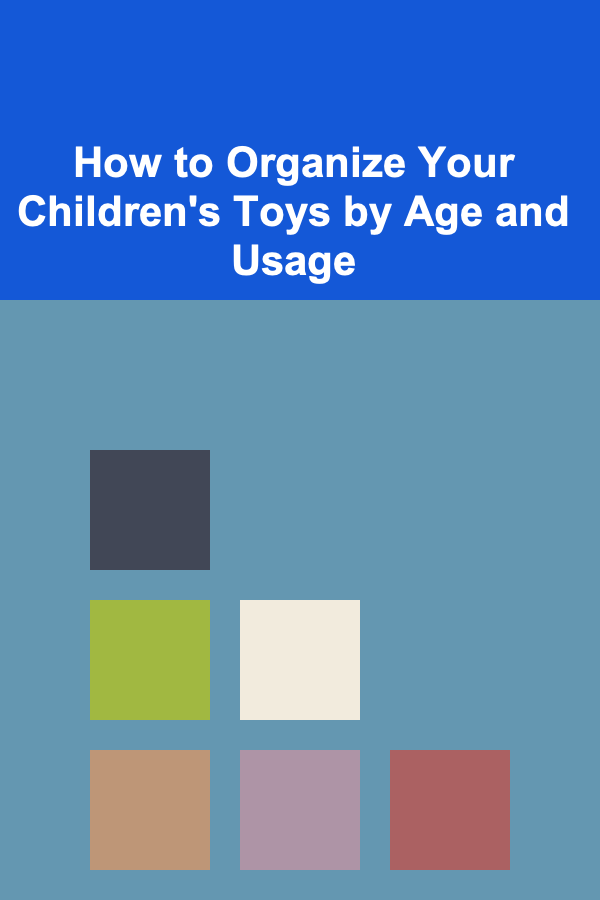
How to Organize Your Children's Toys by Age and Usage
ebook include PDF & Audio bundle (Micro Guide)
$12.99$11.99
Limited Time Offer! Order within the next:

As children grow, their interests and developmental needs evolve. This makes organizing toys not only a necessity for maintaining a tidy space but also crucial for supporting your child's growth and development. An organized toy collection tailored to age and usage can enhance playtime, foster creativity, and reduce clutter in your home. This comprehensive guide will explore effective strategies for organizing children's toys based on age groups and how frequently they are used, ensuring that playtime remains engaging and accessible.
The Importance of Organizing Toys
1. Promotes Developmental Growth
Organizing toys by age helps ensure that children have access to appropriate toys that stimulate learning and development. For instance, infants require sensory toys, while toddlers may benefit from shape sorters and building blocks.
2. Reduces Clutter
A well-organized toy area minimizes clutter, making it easier for both parents and children to find what they need when they need it. This leads to a more serene living environment.
3. Encourages Independent Play
When toys are organized, children can easily access them without needing assistance. This promotes independent play, which is vital for the development of problem-solving skills and creativity.
4. Enhances Responsibility
Involving children in the organization process teaches them responsibility and accountability for their belongings. This skill is valuable as they grow older and manage more aspects of their lives.
5. Eases Clean-Up
An organized system allows children to understand where each toy belongs, making clean-up a less stressful task for both kids and parents.
Assessing Your Space
Before diving into organization strategies, take some time to assess your current toy situation.
1. Evaluate Available Space
a. Identify Areas for Toy Storage
Look around your home for potential storage areas, such as playrooms, bedrooms, or even shared family spaces. Make a list of these areas to determine the best spots for organizing toys.
b. Consider Size and Accessibility
Think about the size of your storage solutions. They should be appropriately sized so that children can easily reach and retrieve toys. Low shelves, bins, or baskets work well for younger children.
2. Inventory Current Toys
a. List All Toys
Create a comprehensive list of all toys currently in your child's possession. This will help you identify duplicates, broken items, and toys that no longer serve a purpose.
b. Categorize Toys
Group toys into categories, such as:
- Infant Toys
- Toddler Toys
- Preschool Toys
- School-Aged Toys
3. Involve Your Children
Engage your children in the assessment process. Ask them about their favorite toys and those they rarely play with. This dialogue can provide insights into what to keep and what to donate or discard.
Organizing Toys by Age Group
Now that you've assessed the space and inventory of toys, it's time to organize them based on age appropriateness.
1. Infant Toys (0-12 Months)
a. Characteristics of Infant Toys
Infant toys should stimulate the senses and encourage motor skills. Key characteristics include:
- Bright colors
- Soft textures
- Sounds and music
b. Recommended Organizational Strategies
- Baskets and Fabric Bins: Use soft baskets for easy access. Ensure these bins are lightweight so that infants or caregivers can move them easily.
- Wall-Mounted Shelves: Keep larger items lightly secured on shelves out of reach until the child is old enough to safely play with them.
2. Toddler Toys (1-3 Years)
a. Characteristics of Toddler Toys
Toddlers are active explorers. Ideal toys include:
- Building blocks
- Shape sorters
- Push-and-pull toys
b. Recommended Organizational Strategies
- Clear Plastic Bins: Utilize clear bins labeled with images or words to help toddlers recognize where each toy belongs.
- Open Shelving Units: Low, open shelving allows toddlers to see and access their toys independently, facilitating free play.
3. Preschool Toys (3-5 Years)
a. Characteristics of Preschool Toys
Preschoolers benefit from toys that promote imaginative play and cognitive development:
- Art supplies
- Puzzles
- Role-playing sets
b. Recommended Organizational Strategies
- Art Carts: Create a mobile art station with bins for crayons, paper, and craft supplies.
- Thematic Bins: Separate toys into themed collections (e.g., animals, vehicles) that preschoolers can easily identify and engage with.
4. School-Aged Toys (6+ Years)
a. Characteristics of School-Aged Toys
As children enter school, they often gravitate toward more complex toys:
- Board games
- Science kits
- Sports equipment
b. Recommended Organizational Strategies
- Game Storage Boxes: Invest in large, sturdy boxes for board games and puzzles, clearly labeling each box for easy identification.
- Vertical Storage Solutions: Utilize hanging organizers for sports equipment or backpacks, maximizing vertical space.
Organizing by Usage Frequency
In addition to age, consider how often toys are used. This will help you create an efficient organizational system.
1. Frequently Used Toys
a. Identify Frequently Used Toys
These are toys that your child plays with daily or weekly. Examples might include:
- Favorite stuffed animals
- Popular board games
- Commonly used art supplies
b. Organizational Strategies
- Accessible Storage: Place frequently used toys at eye level or within easy reach. Use shallow bins or baskets for quick access.
- Rotating System: Implement a rotation system where a selection of frequently used toys is displayed prominently, while others are stored away. This keeps playtime fresh and engaging.
2. Occasionally Used Toys
a. Identify Occasionally Used Toys
These are toys your child plays with from time to time, perhaps seasonally or in specific contexts:
- Outdoor toys (e.g., bikes, kites)
- Holiday-themed items (e.g., Christmas decorations)
b. Organizational Strategies
- Seasonal Bins: Store seasonal or rarely used toys in labeled bins, placing them in higher storage or less accessible areas to declutter everyday spaces.
- Under-Bed Storage: Utilize under-bed bins for larger, seldom-used items, keeping them out of sight until needed.
3. Rarely Used or Broken Toys
a. Identify Rarely Used Toys
These are toys that your child has outgrown or simply doesn't play with anymore.
b. Organizational Strategies
- Donation or Discard: Encourage your child to choose toys they no longer want to keep. Donate or discard these items responsibly, teaching the values of generosity and sustainability.
- Repair Station: Set up a designated area for fixing broken toys, where items can be repaired or recycled appropriately.
Maintaining an Organized Toy Space
Once you have established an organizational system, it's essential to maintain it for long-term success.
1. Regular Decluttering Sessions
a. Schedule Decluttering Days
Set aside time every few months to reassess toy organization. Involve your children in this process to reinforce the value of cleanliness and order.
b. Discuss Toy Usage
During decluttering sessions, talk with your children about which toys they enjoy most and which ones they could part with.
2. Teach Responsibility
a. Assign Clean-Up Tasks
Encourage children to take ownership of their toys. Create a clean-up routine after playtime to instill habits of organization and accountability.
b. Reward Systems
Consider implementing a reward system for maintaining organization. Positive reinforcement can motivate children to participate willingly.
3. Establish Boundaries
a. Limit New Toy Purchases
Discuss with your children the concept of limits concerning new toys. Emphasize that for every new toy purchased, an old one must be donated or discarded.
b. Designate Toy-Free Zones
Establish areas of the house where toys aren't allowed, such as the dining room or bedrooms. This reinforces boundaries and helps keep common spaces tidy.
4. Adapt as Needed
As your children grow and their preferences change, be flexible with your organizational strategies. Reassess periodically to ensure that the system continues to meet their needs.
Conclusion
Organizing your children's toys by age and usage is an ongoing journey rather than a one-time project. By thoughtfully assessing your space, categorizing toys based on age and frequency of use, and implementing effective organizational strategies, you can create a fun, engaging, and efficient play environment for your children.
Moreover, involving your kids in the process fosters a sense of responsibility that will serve them well as they grow. With regular maintenance and adaptability, your organized toy space can contribute significantly to your child's development and joy. Embrace the challenge, and enjoy the benefits of a clutter-free and well-organized play area!
Reading More From Our Other Websites
- [Organization Tip 101] How to Transition Your Wardrobe from Summer to Fall
- [Home Budget Decorating 101] How to Get a High-End Look for Less: Mastering Thrifting and DIYs for Decorating on a Shoestring Budget
- [Toy Making Tip 101] From Fun to Function: Crafting Eco‑Friendly Toys for a Sustainable Future
- [Personal Finance Management 101] How to Adjust Your Financial Planning for Different Life Stages to Reflect Economic Changes
- [Home Budget Decorating 101] How to Decorate a Small Apartment on a Budget
- [Beachcombing Tip 101] Essential Tools and Techniques for Spotting Agates on the Trail
- [Personal Investment 101] How to Start Trading Options Safely for Higher Returns
- [Rock Climbing Tip 101] Safety First: Common Mistakes New Climbers Should Avoid
- [Home Budget Decorating 101] How to Style Shelves with Inexpensive Decor Items
- [Trail Running Tip 101] Gear Guide: Must-Have Shoes, Packs, and Gadgets for Mountain Trail Running

How to Implement a Seasonal Drawer Organization Strategy
Read More
How to Manage Multiple DIY Projects Without Overwhelm
Read More
How to Maximize Under-Sink Storage in Your Bathroom
Read More
How to Stage Your Home's Fireplace for Maximum Impact
Read More
How to Use Airtight Containers to Extend Shelf Life
Read More
How to Handle a Legal Dispute with Your Neighbor
Read MoreOther Products

How to Implement a Seasonal Drawer Organization Strategy
Read More
How to Manage Multiple DIY Projects Without Overwhelm
Read More
How to Maximize Under-Sink Storage in Your Bathroom
Read More
How to Stage Your Home's Fireplace for Maximum Impact
Read More
How to Use Airtight Containers to Extend Shelf Life
Read More